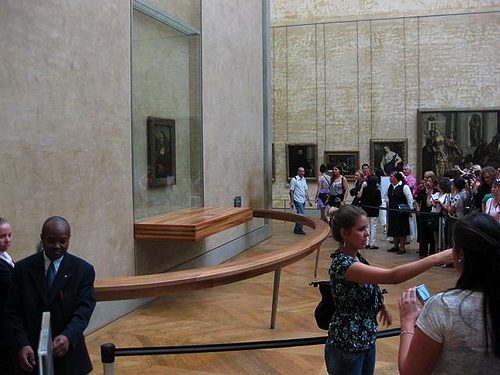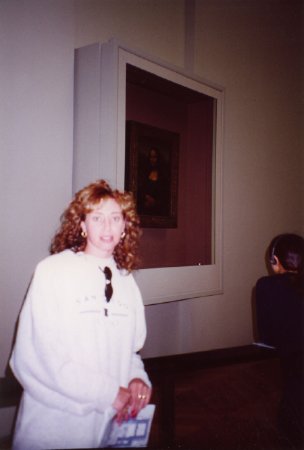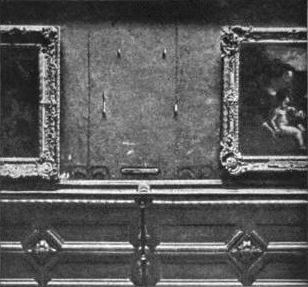
When I first saw Sebastian's stunning photos of the Mona Lisa at C-Monster, I was, naturally, stunned. I haven't been to the Louvre since 2005, when la Joconde was moved to its new, purpose-built space, designed by Peruvian architect Lorenzo Piqueras, la Salle de la Joconde.
When I'd last seen it, it was in its temporary hyperbaric chamber, and looked a lot like this picture from Steve and Sygi's 2001 Mediterranean cruise [which apparently stopped in Paris?]:

And of course, before that, it was in its own similarly sized but nicer capsule in la Salle des Etats, where it was surrounded by several invisible paintings.
So, stunned. Despite having provided a dedicated room, with a freestanding wall, and a massive laminated podium [whose main function, it seems, is to properly position the painting's LED footlight, which is color-calibrated to counter the yellowing effects of age], and a curved rail, the Louvre finds it necessary to add another, temporary ropeline a couple of meters farther back.
This, ironically, for a picture whose most powerful innovation, according to the Louvre curator of 16th century art Cecile Scaillerez, is "abolish[ing] the distance between the model and the viewer by getting rid of a foreground, which created a barrier in pictures of the time."
The sheer scale of the ridiculousness of this museological condition set my mind racing. The Mona Lisa has been moved eight times within the Louvre. Wouldn't it be awesome to do a show where each work--I don't know what, but they're probably some paintings or whatever, that's not important now--is shown in a recreation of each of these various installations?
Ooh, there'd be that classic belle epoque 1911 hang it was stolen from:

You could just whip up a chair rail out of injection molded plastic or whatever, paint the whole thing White Cube White, maybe Triple Candie the vitrines and railings a bit to provide suitably ironic recontextualization.
And five or so others, I guess. What do they look--wow, searching for photos of the Mona Lisa is mind-numbingly boring. Did you know there's even stock photography of excessive crowd control measures in front of the Mona Lisa that looks like half the photos of the Mona Lisa in the world?

Or that the other half are photos of people taking photos of the Mona Lisa? Turns out if someone isn't actually coming to the Louvre on a pilgrimage to see the World's Greatest Painting, they're coming to self-consciously note their position at the vortex of the painting's massive cultural scrum.
So the Mona Lisa and contemporary art: is there anything interesting or useful to be learned, studied or said? When you're one of six billion monkeys who've stepped away from our typewriters for a bit to take in some Art, the odds that you are the one who's going to spit out something worthwhile are pretty damn slim.
But there's a world of difference between "there's nothing left to say" and "there's nothing to be said," and what does it mean for the contemporary art world if all it can do is gawk, sneer, or sigh at the Louvre's greatest attraction?

Thomas Struth, Musee du Louvre, IV, 1989
It seems folly to carve it out and claim it's irrelevant. Did you know that the official American artscape [sic] of the last two generations--blockbuster museum exhibitions and the NEA and NEH included--is a direct result of Jacqueline Kennedy seducing Andre Malraux into loaning the Mona Lisa to the National Gallery and the Met in December 1962? And that Jackie enlisted Mark Rothko, Franz Kline, and Andrew Wyeth [?] in her plan? I did not. Until I read Bob's blog post about Margaret Leslie Davis's book, Mona Lisa in Camelot. Here's a picture from Davis's website of the Mona Lisa getting off the boat in New York:













